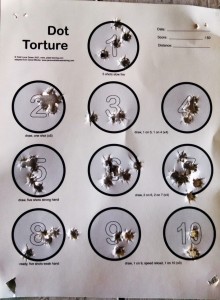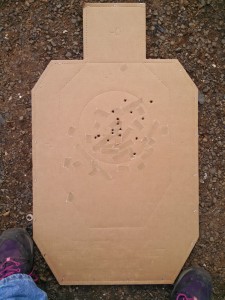While the rest of the country remains locked in the grip of the Winter That Never Ends, the weather here in the Pacific Northwest has been unseasonably mild — so much so, that the daffodils are blooming, the cherry trees are in full bloom, and my youngest son keeps wandering around the house in shorts and flipflops without so much as a glance at the calendar. It’s not normal for us to get even a few days of consecutive sunshine this time of year, and yet for the past few weeks our porch kitty has been drowsing in the sun every afternoon. Weird.
So of course yesterday afternoon found me at the range with a buddy. First we shot Dot Torture drills at 7 yards. Those are always humbling, and sometimes annoying. My inner perfectionist (who is a whiny little child) hates DT drills like the whiny little child she is. My grownup self enjoys the challenge, but I always have to stifle the urge to cry for a Mulligan with the first dropped shot.
And yes, there’s nearly always a dropped shot.
That’s because the goal is continuous improvement. You first shoot the entire DT course of fire from 3 yards, untimed, until you can do it perfectly. That might take months of regular practice. Because it requires your full concentration, it’s a surprisingly tough course of fire even at close ranges. Once you can do it perfectly at one distance, you either move farther away from the target or you add some time stress. Or both. It’s a deceptively simple series of exercises, and if you use it regularly you’ll always find yourself being stretched as a shooter.
For the skills covered and the trigger control required, I believe Dot Torture is one of the best practice time investments you can make in 50 rounds. The drill forces you to run through your basic gunhandling and requires excellent marksmanship out of the holster, after a reload, transitioning between targets, single handed with either hand… you get the idea. It’s not just marksmanship, but marksmanship skills performed in context. Some people can’t ever seem to hit the target after a reload, for example. Dot Torture helps prevent that problem or cure it. It’s also a very restful high-concentration routine that forces your mind into the here and now, like some types of yoga.
But my inner perfectionist still hates it.
When we finished our DT workout, we shifted over to the moving targets. The system we use runs the targets on a side-to-side track at varying speeds. We set it up to run a single IDPA target between two barrels set roughly ten feet apart, so that the target would take roughly two seconds to cover the distance between the barrels. We worked out of the holster at 7 yards, to get two shots into the center circle every time the target ran between the barrels.
My first run — which I shot from the holster but without a cover garment — exposed a nasty little flinch problem. You can see the tape over the dropped shot on the outer edge of the -1 zone in the lower left, though I’d rather you didn’t. Two or three runs later, I’d settled down and was getting nearly all my hits in the center circle, which felt nice.
It turns out that watching the front sight and pressing the trigger smoothly really help you hit your target even when it’s moving.
When my turn rolled around again, I put my cover shirt on and worked my draw from concealment. Still plenty of time for a good draw and two smooth presses of the trigger on that moving target, but no time for fumbles or bumbles during the process.
Toward the end, we changed the procedure so we could work on the “trapping” technique for moving targets. With this technique, you simply put your sights over the place where you know the target will appear, and remain unmoving until the target gets there. You must fire a single shot at the exact moment the sights are aligned in the center of the target, before the target moves out of your view.
The trapping drill on moving targets really exposes flinch and trigger mash problems, since it forces you to press the trigger Right Now when the target appears in front of your sights. But it’s very satisfying when you nail it.
Altogether, we each ran through around 100 rounds and walked off the range with smiles. It was a good day.






